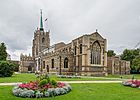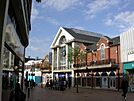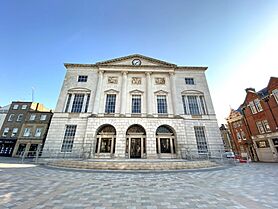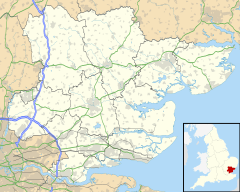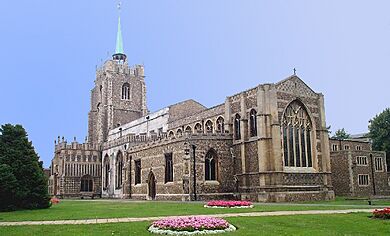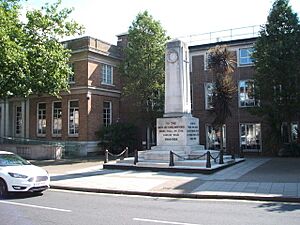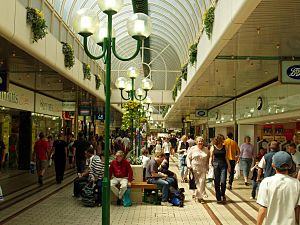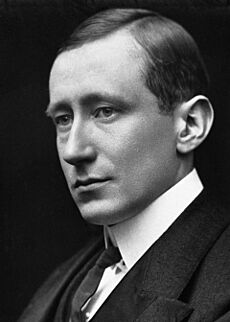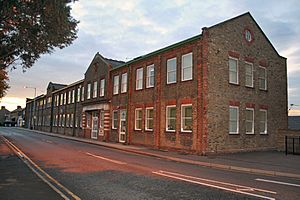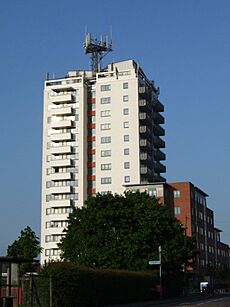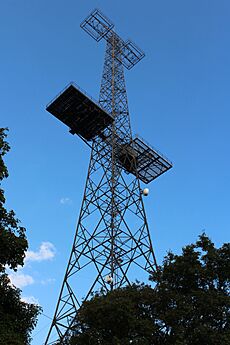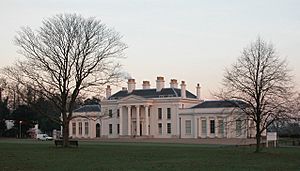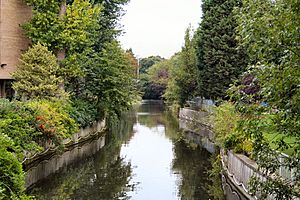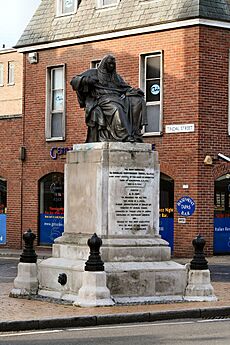Chelmsford facts for kids
Quick facts for kids Chelmsford |
|
|---|---|
| City | |
|
Clockwise from top, left to right: Chelmsford Cathedral; Shopping Centre; Hylands House; Admiral's Park; City Centre and Shire Hall |
|
| Population | 110,625 (2021 Census) |
| OS grid reference | TL7107 |
| District | |
| Shire county | |
| Region | |
| Country | England |
| Sovereign state | United Kingdom |
| Post town | CHELMSFORD |
| Postcode district | CM1, CM2, CM3 |
| Dialling code | 01245 |
| Police | Essex |
| Fire | Essex |
| Ambulance | East of England |
| EU Parliament | East of England |
| UK Parliament |
|
Chelmsford (pronounced CHLEMZ-furd) is a city in the county of Essex, England. It is the main town of Essex. Chelmsford is one of three cities in the county, along with Colchester and Southend-on-Sea. It is about 31 miles (50 km) north-east of London.
In 2021, the city area had a population of 110,625 people. People who live in Chelmsford are called "Chelmsfordians". Some towns in other countries, like Chelmsford, Massachusetts, in the USA, are named after this city.
Contents
History of Chelmsford
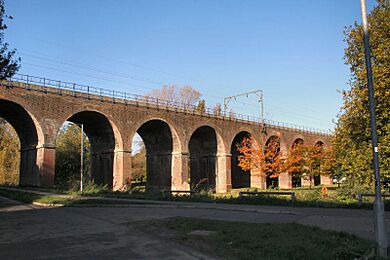
Early Beginnings
People have lived in the Chelmsford area for a very long time. Scientists have found signs of settlements from the Neolithic (New Stone Age) and late Bronze Age in the Springfield area.
The Romans also lived here. They built a fort in AD 60. A town grew around it, called Caesaromagus, which means 'Caesar's field' or 'Caesar's marketplace'. It might have been planned as an important Roman capital. You can still find remains of Roman buildings under the modern streets.
After the Romans left Britain, the town disappeared for a while. An Anglo-Saxon burial site was found north of Chelmsford. The road 'Saxon Way' is now there.
The city's name comes from Ceolmaer's ford. A ford is a shallow place in a river where you can cross. This ford was near where the High Street bridge is today. In 1086, the town was called Celmeresfort. By 1189, it was known as Chelmsford. Its location on a main Roman road (now the A12) helped it become successful early on.
Royal Charter and County Town Status
In 1199, King John gave Chelmsford a special permission called a royal charter. This allowed the town to hold a market. This happened after a bridge was built over the River Can. Even today, an indoor market is a key part of the city centre.
Chelmsford became the main place for local courts in the early 1200s. By 1218, it was officially named the county town of Essex. It has kept this important role ever since.
Royal Connections and Rebellions
Robert I of Scotland, also known as Robert the Bruce, had links to the nearby village of Writtle. Some people believe he was born there.
Chelmsford played a big part in the Peasants' Revolt of 1381. This was a major uprising by ordinary people against the government. After stopping the rebellion in London, King Richard II came to Chelmsford. For almost a week, Chelmsford became the centre of government. The King and his advisors stayed here. They worked to calm the kingdom and manage daily government tasks. Richard II famously took back promises he had made to the peasants while in Chelmsford. This means that for a few days, Chelmsford was like the capital of England!
King Henry VIII bought land here in 1516. He built Beaulieu Palace where New Hall School is now. This palace later became home to his wife, Anne Boleyn. After that, his daughter, Mary I, lived there.
The Birthplace of Radio
Chelmsford is famous for being the "birthplace of radio".
- In 1899, Guglielmo Marconi opened the world's first "wireless" or radio factory in Hall Street.
- In 1920, Marconi made the first official public sound broadcast in the UK. This happened at the New Street Works, which was the world's first factory built just for radio. Famous singer Dame Nellie Melba performed.
- In 1922, the world's first regular radio shows for entertainment began from Marconi's labs in Writtle. This station, called "2MT", led to the creation of "2LO" in London, which then led to the BBC.
World War II Impact
During World War II, Chelmsford was important for making things needed for the war. Because of this, it was attacked by enemy aircraft and rockets.
The worst attack happened on December 19, 1944. A V2 rocket hit Henry Road, a street near important factories. Thirty-nine people died, and many more were hurt.
On May 14, 1943, bombs hit Chelmsford, killing over 50 people and leaving many homeless. Hylands Park was used as a prisoner of war camp. From 1944 to 1945, it was also the headquarters for the Special Air Service (SAS), a special forces unit.
Becoming a City
Chelmsford officially became a city on June 6, 2012. This was a special event to celebrate the Diamond Jubilee of Queen Elizabeth II. The announcement was made on March 14, 2012.
Local Government and Politics
Chelmsford is the main centre for government in Essex. It has been the county town since 1215. The main offices for Essex County Council are at County Hall. The offices for Chelmsford City Council are at Chelmsford Civic Centre.
The headquarters of Essex Police (the local police force) are also in Chelmsford.
Chelmsford was made a municipal borough in 1888. In 1974, it became the larger Borough of Chelmsford. In 2012, it was granted city status.
For the UK Parliament, Chelmsford is represented by Marie Goldman. She was elected in the 2024 general election.
Economy and Business
Chelmsford started as a farming and market town. But since the 1800s, it has been an important place for industry. After the Chelmer and Blackwater Navigation canal opened in 1797, it became easier to transport goods. This helped industries like milling and malting grow. Later, factories making farm machinery opened.
Today, Chelmsford is a commercial city. Many national and international companies have offices here, including M&G Group and Teledyne e2v. About 80,000 people work in Chelmsford.
The city has three main shopping centres: Bond Street, High Chelmer, and The Meadows. There are also several retail parks. A large John Lewis department store opened in 2016.
Chelmsford has a lively nightlife with many pubs, bars, and restaurants. Its central location and good transport links make it easy for people to visit.
Marconi's Legacy
In 1899, Guglielmo Marconi opened the world's first "wireless" factory in Hall Street. It was called 'The Marconi Wireless Telegraph & Signal Company'. This is why Chelmsford is known as the "birthplace of radio".
The company grew and moved to a bigger factory, the New Street Works, in 1912. This factory hosted the first official public sound broadcast in the UK in 1920. In 1922, the world's first regular radio entertainment shows began from Marconi's labs nearby.
Over the years, parts of Marconi's business were sold. The Marconi name left Chelmsford in 2008. The old New Street factory was mostly taken down in 2013 to make way for new homes. Only a few historic parts remain.
Cromptons Electrical Engineering
Chelmsford was also home to the UK's first electrical engineering factory. It was started by Rookes Evelyn Bell Crompton. He was a leader in electrical engineering. He helped create electric street lighting and electric motors for trains.
Crompton installed electric street lights in Chelmsford in 1888. His factory, called the 'Arc Works', made electrical equipment for power stations around the world. The factory closed in 1992. Now, a housing development called 'The Village' is on the site. Its street names remember Crompton.
Hoffmann Ball Bearings
Hoffmann Ball Bearings was another big employer in Chelmsford. They made ball bearings, which are important parts in machines. These bearings were even used in early flights across the Atlantic Ocean.
The company later became Ransome Hoffmann and Pollard (R.H.P.). Most of the old factory was taken down in 1990. The Anglia Ruskin University now has a campus on that site.
English Electric Valve Company (Teledyne e2v)
The English Electric Valve Company (EEV) started in Chelmsford in the 1940s. It made special electronic parts like magnetrons for radar systems. EEV became a very important high-tech company.
In 2017, a US company called Teledyne Technologies bought EEV. It is now called Teledyne e2v and still operates in Chelmsford.
Britvic Soft Drinks
The Britvic soft drink company started in Chelmsford in 1948 as the British Vitamin Company. Its roots go back to a chemist's shop in Tindal Street that sold flavoured waters in the mid-1800s.
Britvic grew over the years, buying popular brands like R. White's Lemonade, Tango, and Robinson's. It also got the UK rights for Pepsi and 7 Up.
In 2012, Britvic planned to merge with A.G. Barr, which makes Irn-Bru. However, this merger did not happen. Britvic's UK headquarters moved from Chelmsford in 2012. The factory in Chelmsford closed in 2014, ending the company's long history with the city.
Transport in Chelmsford
Railway Travel
The railway came to Chelmsford in 1842. Three large bridges, called viaducts, were built to carry the tracks. The longest one has 18 arches and goes through Central Park.
Greater Anglia trains run from Chelmsford railway station. You can travel south to London Liverpool Street or north to places like Colchester and Norwich. About 14,000 people travel to London by train from Chelmsford every day. This makes it one of the busiest stations outside London that isn't a final stop.
A second railway station, called Beaulieu Park, is being built. It will serve new housing areas in the north-east of Chelmsford and is expected to open in late 2025.
Bus Services
The main bus station in Duke Street was built in 2007. It has shops and apartments above it.
First Essex is the main bus company, with routes around Chelmsford and to nearby towns like Basildon and Colchester. There are also special school buses. Other companies like Arriva Colchester and Stephensons of Essex also run services.
Chelmsford has two park & ride services. These allow people to park their cars outside the city and take a bus into the centre. One is at Sandon and opened in 2006. The other, the Chelmer Valley Park and Ride, opened in 2011.
Road Network
The A12 is a major road that connects east London to Lowestoft. It used to go through Chelmsford, but a bypass was built in 1986. This bypass helps traffic flow around the city.
The A414 road connects Chelmsford to Hemel Hempstead and Maldon. It also links to the M11 motorway. Other important roads include the A130 and the A131. The nearest motorway is the M25, about 14 miles away.
The Army and Navy roundabout in the city is known for traffic jams. It used to have a special flyover that changed direction depending on the time of day. This flyover was closed in 2019 because it was unsafe. A new road bridge, the A138 Chelmer Viaduct, was built in 2015 to replace an older one. Plans for a new 'hamburger' roundabout at the Army and Navy junction were announced in 2024.
To save energy, many street lights in Chelmsford are switched off between 1:00 am and 5:00 am on most nights.
Air Travel
Chelmsford is about 25-30 minutes by road from Stansted Airport. Other major airports like London Heathrow, London Gatwick, and Luton can be reached by train.
Redevelopment and Growth
Chelmsford has seen many new building projects. The old bus station site in Duke Street was redeveloped in 2007. It now has a new bus station, shops, and apartments.
A large new housing area is being built near Beaulieu Park. It will be like a small village with about 3,500 homes. The old Army and Navy pub was replaced by a hotel and restaurants.
There are plans for a new development called Waterside along the River Chelmer. This would include shops, bars, and restaurants. The former Anglia Ruskin University campus was redeveloped into new homes and shops called City Park West.
The High Chelmer shopping centre was updated in 2008/2009. A new John Lewis store opened in 2016 as part of a big retail development at Bond Street.
Places to Visit
Hylands House and Park are just west of the city. This country house and park were saved by the local council in 1966. The house, built in 1730, has been fully restored. The 574-acre (232 ha) park has woodlands, grasslands, and lakes. It has hosted big events like the V Festival music festival and the 21st World Scout Jamboree 2007. There is also a large children's play area.
Chelmsford Museum is in Oaklands Park. It tells the story of local history and industry. It also includes the Essex Regiment Museum. The museum was expanded in 2010 and again in 2019. It has displays about Crompton, Marconi, and Hoffmann, and shows how the city developed from ancient times. Another museum site, Sandford Mill, shows more about Chelmsford's history in telecommunications and engineering.
The Shire Hall is at the top of the High Street. It was built in 1791 and has a grand stone front. It was originally a courthouse, and courts have been on this site since 1199. However, a new magistrates' court opened nearby in 2012.
Chelmsford Cathedral is one of the oldest buildings in the city. It was built in the 1400s and became a cathedral in 1914. It is the second smallest cathedral in England.
Chelmsford Prison is a prison for men and young offenders. It was built in 1830.
The 18-arch Victorian railway viaduct in Central Park was built in 1842. It carries the Great Eastern Main Line over the River Can.
Chelmsford's two tallest buildings are Parkside Court (built in 1962) and the 13-floor "Kings Tower" (completed in 2007). Both are about 141 feet (43 metres) tall.
The tallest structure in the area is the old Chain Home radar tower in Great Baddow. It stands 360 feet (110 metres) tall. It was built in 1937 and moved to Great Baddow in 1956. It is the only Chain Home tower still in its original form in the UK and is a well-known landmark. It was given special protection as a Grade II listed building in 2019.
Geography and Climate
Rivers and Flooding
Chelmsford has two rivers: the River Can and the River Chelmer. They join together east of the city to form the Chelmer and Blackwater Navigation, which flows towards Maldon and then into the sea. The Chelmer comes from the north, and the Can comes from the west.
Before the 1960s, these rivers often flooded the city centre. There were big floods in 1888 and 1958. Since then, flood prevention projects have largely stopped major flooding in the city centre. However, natural floodplains outside the city still flood after heavy rain.
Weather in Chelmsford
Chelmsford has a mild climate, like most of the UK. It has warm summers and cool winters. Being in the south-east of England, it is warmer and drier than many other parts of the country.
The highest temperature ever recorded in Chelmsford was 39.1°C (102.4°F) on July 19, 2022. The coldest was -20.6°C (-5.1°F) on January 29, 1947. Frost happens on about 53 nights a year.
Chelmsford gets about 591.8 mm of rain each year. Rain falls on about 108 days a year. Thunderstorms are not common and usually happen in July and August.
| Climate data for Writtle, elevation: 32 m (105 ft), 1981–2010 normals, extremes 1960–present | |||||||||||||
|---|---|---|---|---|---|---|---|---|---|---|---|---|---|
| Month | Jan | Feb | Mar | Apr | May | Jun | Jul | Aug | Sep | Oct | Nov | Dec | Year |
| Record high °C (°F) | 15.1 (59.2) |
18.4 (65.1) |
22.8 (73.0) |
27.0 (80.6) |
30.0 (86.0) |
34.4 (93.9) |
39.1 (102.4) |
35.7 (96.3) |
32.1 (89.8) |
28.6 (83.5) |
18.5 (65.3) |
16.6 (61.9) |
39.1 (102.4) |
| Mean daily maximum °C (°F) | 7.4 (45.3) |
7.7 (45.9) |
10.7 (51.3) |
13.6 (56.5) |
17.0 (62.6) |
20.2 (68.4) |
22.9 (73.2) |
22.7 (72.9) |
19.3 (66.7) |
15.0 (59.0) |
10.5 (50.9) |
7.7 (45.9) |
14.6 (58.3) |
| Daily mean °C (°F) | 4.5 (40.1) |
4.4 (39.9) |
6.7 (44.1) |
8.7 (47.7) |
11.9 (53.4) |
15.0 (59.0) |
17.5 (63.5) |
17.3 (63.1) |
14.5 (58.1) |
11.1 (52.0) |
7.2 (45.0) |
4.8 (40.6) |
10.3 (50.5) |
| Mean daily minimum °C (°F) | 1.5 (34.7) |
1.0 (33.8) |
2.7 (36.9) |
3.8 (38.8) |
6.8 (44.2) |
9.8 (49.6) |
12.0 (53.6) |
11.8 (53.2) |
9.7 (49.5) |
7.1 (44.8) |
3.9 (39.0) |
1.8 (35.2) |
6.0 (42.8) |
| Record low °C (°F) | −20.6 (−5.1) |
−13.3 (8.1) |
−11.1 (12.0) |
−6.1 (21.0) |
−2.8 (27.0) |
−1.7 (28.9) |
2.2 (36.0) |
0.6 (33.1) |
−1.1 (30.0) |
−6.7 (19.9) |
−8.1 (17.4) |
−18.0 (−0.4) |
−20.6 (−5.1) |
| Average precipitation mm (inches) | 53.2 (2.09) |
39.2 (1.54) |
40.2 (1.58) |
41.6 (1.64) |
48.7 (1.92) |
49.9 (1.96) |
44.3 (1.74) |
51.7 (2.04) |
48.6 (1.91) |
64.1 (2.52) |
58.0 (2.28) |
52.3 (2.06) |
591.8 (23.30) |
| Average precipitation days (≥ 1.0 mm) | 10.8 | 8.6 | 9.2 | 9.2 | 8.7 | 8.5 | 7.3 | 7.7 | 7.8 | 10.1 | 9.9 | 10.2 | 108.1 |
| Mean monthly sunshine hours | 58.0 | 76.1 | 112.4 | 165.7 | 196.6 | 198.2 | 209.9 | 204.0 | 147.4 | 113.9 | 68.7 | 47.4 | 1,598.2 |
| Source 1: Met Office | |||||||||||||
| Source 2: KNMI | |||||||||||||
Education in Chelmsford
Chelmsford has many schools and colleges. For higher education, there is a campus of Anglia Ruskin University and Writtle University College. Chelmsford College provides further education. Many secondary schools also have sixth forms.
Some of the secondary schools in Chelmsford include:
- The Boswells School
- The Beaulieu Park School
- Chelmer Valley High School
- Columbus School and College
- Chelmsford County High School for Girls
- Great Baddow High School
- Hylands School
- King Edward VI Grammar School
- Moulsham High School
- New Hall School
- The Sandon School
- St John Payne Catholic School
- Thriftwood School and College
There are also many primary schools, including The Bishop's C of E & R C Primary School, which is one of the few joint Anglican and Roman Catholic primary schools in the country.
Society and Culture
Media and Radio
Chelmsford is often called the Birthplace of Radio.
- City Sound Radio started broadcasting online and digitally in September 2023. It shares local news, music, and supports local musicians.
- Chelmsford Community Radio (CCR) broadcasts on 104.4FM. It began online in 2013 and got its FM license in 2015. It offers many different shows and supports local groups.
- Radio Essex (formerly Chelmsford Radio) broadcasts to the area.
- BBC Essex has been on air since 1986 and has studios in Chelmsford.
- There is also an award-winning Hospital Radio Station at Broomfield Hospital. It has been running since 1964 and broadcasts 24 hours a day for patients.
Chelmsford also has its own Film Festival, which started in 2017. It mainly takes place at the Everyman Cinema.
Local publications include the Essex Chronicle, which started in 1764 and is one of the longest continuously published newspapers in the country.
Visual Art
In May 2022, Chelmsford held its first street art festival, Concrete Canvas. About 30 murals were created around the city by local and international artists. The festival continued in May 2023, adding 43 more artworks.
Religion
Chelmsford Cathedral is the second smallest cathedral in England. It became a cathedral in 1914. It covers all of Essex and parts of East London.
Chelmsford also has three Catholic churches and a Norbertine canonry. Other religious groups like Baptists, Jehovah's Witnesses, Quakers, and Muslims also have places of worship in the city. The main mosque is on Moulsham Street.
Sports in Chelmsford
Essex County Cricket Club is based at the County Ground. They are one of the top cricket clubs in England.
Chelmsford City Football Club plays in the National League South. Their home ground is at the Chelmsford Sport and Athletics Centre. Chelmsford is one of the largest towns in England without a team in the top professional football leagues.
The Chelmsford Rugby Football Club was started in 1920. They have many teams for both adults and young players.
Chelmsford Hockey Club has men's and ladies' field hockey teams.
Chelmsford Swimming Club has been around for over 100 years. It is located in the Riverside Ice and Leisure building. The Chelmsford Chieftains, an ice hockey team, also play there.
Horse racing used to take place at Galleywood until 1935. A new racecourse, Chelmsford City Racecourse, opened in 2008 at Great Leighs.
Since 2014, the city has held a marathon. It starts and ends in the city centre and goes through the city and surrounding areas.
Notable People from Chelmsford
Musicians
- Bon Harris (born 1965), from the electronic music group Nitzer Ebb.
- Harry Judd (born 1985), drummer for McFly.
- Hazell Dean (born 1952), singer.
- Sarah Cracknell (born 1965), singer for Saint Etienne.
- Brothers Tom Jenkinson (born 1975) and Andy Jenkinson (born 1979), electronic musicians.
Sportspeople
- Angela Addison (born 1999), professional footballer.
- Oliver Bearman (born 2005), racing driver.
- Liam Chilvers (born 1981), professional footballer.
- Sam Cook (born 1997), cricketer.
- Darren Eales (born 1972), chief executive of Newcastle United football club.
- Nathan French (born 1990), Olympic volleyball player.
- James Gibson (born 1980), swimmer.
- Greg Halford (born 1984), professional footballer.
- Isaac Hayden (born 1995), professional footballer.
- Gus Kenworthy (born 1991), freestyle skier.
- James Key (born 1972), F1 designer.
- Nigel Spink (born 1958), professional footballer.
- Richard Westbrook (born 1975), racing driver.
Actors
- Tom Payne (born 1982), actor.
- Mike Edmonds (born 1944), actor.
- Joe Thomas (born 1983), actor.
Artists
- Sir Grayson Perry (born 1960), artist and broadcaster.
- Richard Spare (born 1951), artist.
- Cheryl Hole (born 1993), drag queen.
Other Notable People
- Florence Attridge (1901–1975), helped make secret radios during the war.
- Anne Knight (1786–1862), activist for anti-slavery and women's rights.
- Sarah Perry (born 1979), writer.
- Sir Nicholas Conyngham Tindal (1776–1846), a famous lawyer and judge.
- Jon Morter (born 1974), campaigner.
- Ronald Skirth (1897–1977), World War I veteran.
- Sir Walter Mildmay (1523–1589), important government official under Queen Elizabeth I.
- J. A. Baker (1926–1987), writer and naturalist.
- Steve Blame (born 1959), VJ on MTV.
- Ed Woodward (born 1971), former chief executive of Manchester United football club.
- The Lord Dannatt (born 1950), British Army officer and politician.
Twin Towns
Chelmsford has official twin towns:
The city also has a sister city:
- Wuxi, China
See also
 In Spanish: Chelmsford para niños
In Spanish: Chelmsford para niños


